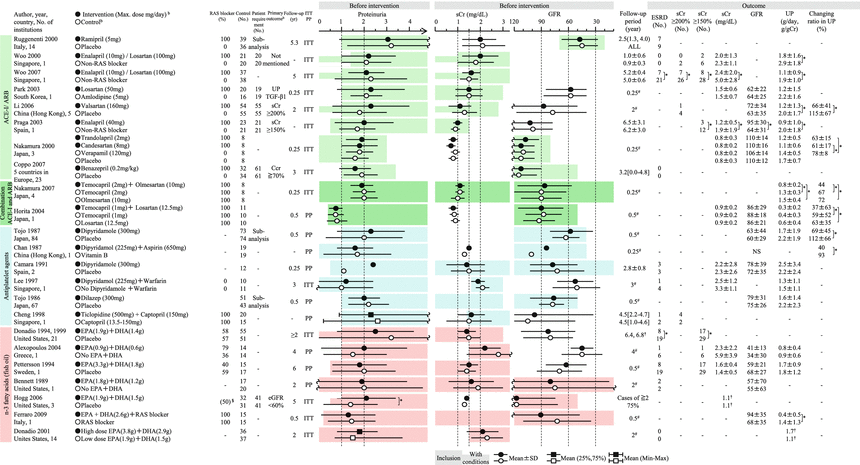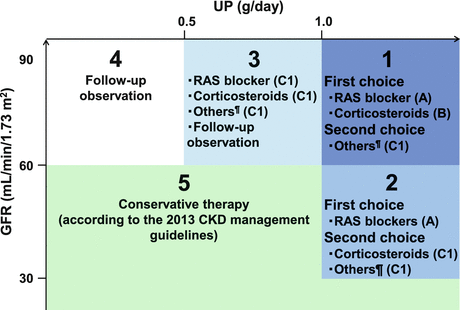Fig. 15.1
Working group for the development of Clinical Guidelines for IgA Nephropathy, Progressive Renal Diseases Research by the Japanese Society of Nephrology, and Research on Intractable Disease by the Ministry of Health, Labour and Welfare of Japan
15.2 Characteristics of the Japanese Clinical Guidelines for IgA Nephropathy
The purpose of the Clinical Guidelines for IgA Nephropathy 2014 was to define evidence-based clinical guidelines that reflect the clinical situation of IgAN in Japan. This guideline is developed to provide answers to clinical questions (CQs) that nephrologists may encounter in the clinical practice for the treatment of IgAN. Each answer is shown as a statement, and recommendation grades based on the evidence-based levels are noted for each statement in the treatment section (Table 15.1). It was not aimed at creating an exhaustive textbook but at supporting clinical decisions by answering questions raised by nephrologists in clinical practice and establishing a standard treatment. With the aim of comprehensively supporting nephrologists in the treatment of IgAN in clinical settings, the Clinical Guidelines for IgA Nephropathy 2014 Advisory Committee independently evaluated the results of principal randomized parallel-group clinical trials published to date (Figs. 15.2 and 15.3) and presented the scheme of indications for preventive intervention of renal dysfunction progression in this guideline (Fig. 15.4). Now, the indications of therapeutic interventions of IgAN are mainly based on GFR and urinary protein level in this guideline and also the evidence-based practice guideline for the treatment of chronic kidney disease (CKD) [4]. The Clinical Guidelines for IgA Nephropathy 2014 also describe the characteristics and treatment of pediatric IgAN.



Table 15.1
Rating description of the guideline recommendations
Recommendation grade |
|---|
A. Strongly recommended for implementation in routine clinical practice because of sufficient evidence |
B. Recommended for implementation in routine clinical practice because of some evidence |
C1. Might be implemented in routine clinical practice despite insufficient evidence |
C2. Not recommended for implementation in routine clinical practice because of insufficient evidence |
D. Not recommended for implementation in routine clinical practice because of evidence that it might be harmful to patients |

Fig. 15.2
Summary of the randomized controlled trials of corticosteroids and immunosuppressive agents in adult IgAN patients. AZA azathioprine, CPA cyclophosphamide, CyA cyclosporin, ITT intention to treat, MMF mycophenolate mofetil, mPSL methylprednisolone, MZR mizoribine, PP pet protocol, PSL prednisolone, PSN prednisone. Mean ± SD, median (25 %, 75 %), mean or median [range]. -NA, *P < 0.05, §administration rate before intervention, #scheduled follow-up period, †median. aIndicated when the administration period is limited. bIndicated only when the number needed to treat is calculated

Fig. 15.3
Summary of the randomized controlled trials of RAS blockers, antiplatelet agents, and fish oils in adult patients with IgAN. EPA eicosapentaenoic acid, DHA docosahexaenoic acid, ITT intention to treat, NS not significant, PP pet protocol, SI selectivity index. Mean ± SD, median (25 %, 75 %), mean or median [range]. -NA, *P < 0.05, §administration rate before intervention, # scheduled follow-up period, †median. aIndicated only when administration period is limited. bThe approved maximum daily dose (mg) of antihypertensive drug in Japan/JNC7 recommended dose in the United States (mg): amlodipine (10/10), enalapril (10/40), olmesartan (40/40), captopril (150/100), candesartan cilexetil (12/32), temocapril hydrochloride (4/−), trandolapril (2/4), valsartan (160/320), benazepril hydrochloride (10/40), verapamil (360/360), ramipril (−/10), and losartan potassium (100/100). cIndicated only when the number needed to treat is calculated

Fig. 15.4
Outline of the treatment of IgAN in adults, with a focus on the prevention of renal dysfunction. Others: tonsillectomy (combined with high-dose pulse corticosteroid therapy) and therapy with nonsteroidal immunosuppressive agents, antiplatelet agents, and n-3 fatty acids (fish oil). This figure shows the indications for treatment intervention, based mainly on the results (Figs. 15.2 and 15.3) of RCTs, often focusing on renal function and amount of urinary protein excreted as patient inclusion/exclusion criteria. In actual clinical practice, besides renal function and urinary protein level, other factors such as renal histopathological findings and age should also be considered to carefully decide the indications for these treatment interventions. Hypertension (CKD Guideline, Chap. 4), salt intake (Chaps. 3 and 4), lipid disorders (Chap. 14), glucose intolerance (Chap. 9), obesity (Chap. 15), smoking (Chap. 2), anemia (Chap. 7), CKD mineral and bone disorders (CKD-MBD, Chap. 8), and metabolic acidosis (Chap. 3) should also be managed as necessary
The Clinical Guidelines for IgA Nephropathy 2014 comprehensively covers the concept, diagnosis, pathology, epidemiology, and adverse effects of treatment, as well as the standard treatment of IgAN (Table 15.2), actively presenting the data obtained from Japanese patients in figures and tables. IgAN can be definitely diagnosed when kidney biopsy results show IgA deposition within the renal glomerular mesangium. However, glomerular IgA deposition can occur in normal kidneys. Thus, Japanese guidelines define IgAN as follows: IgAN is a disease characterized by urinary findings suggestive of glomerulonephritis; predominantly, IgA is deposited in the glomeruli, with no evidence of other underlying diseases. Glomerular hematuria and proteinuria are urinary findings that suggest glomerulonephritis.
Table 15.2
Table of contents of the Japanese Clinical Guidelines for IgA Nephropathy
I. Introduction |
1. Definition and background |
2. Pathogenesis and pathophysiology |
1. Overview |
2. Genetics |
3. Abnormal IgA molecules |
4. Mucosal immunity |
5. IgA1 glomerular deposition |
6. Glomerular damage < div class='tao-gold-member'>
Only gold members can continue reading. Log In or Register to continue
Stay updated, free articles. Join our Telegram channel
Full access? Get Clinical Tree
 Get Clinical Tree app for offline access
Get Clinical Tree app for offline access

|




